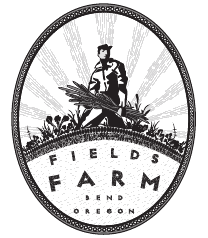It’s that time of the year when arugula starts sprouting reminding us that spring really will come and our diet will change from root vegetables to greens and lot of them! In that spirit CSA shares and Farm Bucks are now available for purchase.
CSA shares are $610.00 for the full season with pick-up here at the farm. For those who want to try out our produce or are growing some of their own Farm Bucks will be sold for $95.00 for $100.00 of Farm Bucks or $180.00 for $200.00 of Farm Bucks. Farm Bucks can be used at the farm or at the Bend Farmer’s Market.
2010 CSA shares and Farm Bucks
post by: Debbie Fields February 24, 2010
Small Farms or Destination Resorts?
post by: Debbie Fields January 30, 2010
Some Winter reading:A thoughtful article today in the BendBulletin about local Agriculture implies even more issues than it brings up. Included are some juicy quotes from Jim.The article is ironic as it tells the story of small local farmers who quit because of the difficult market. Unmentioned is what is creating this market, our industrialized food production system. Countervailing this are small Farmers like Fields Farm who are on upsurge catering to massive crowds at Farmer’s Markets and long waiting lists for CSAs.So while Big Agribusiness is killing small local farms, at the same time, it is giving rise to…small local farms.
Happy New Year
post by: Debbie Fields January 1, 2010
We want to thank all of you for supporting our farm, enjoying our veggies and berries and your pleasant company. We so enjoy being part of this community. We wish you a very happy 2010. Look for our CSA announcement the end of February. Eggs will continue to be available through the winter.
What’s Available
post by: Debbie Fields November 29, 2009
We’ve got fresh eggs, including some delectable turkey eggs. Potato varieties for this week include Red Norlands, All Blues, Colorado Rose and Russian
Banana Fingerlings. Mild red and yellow onions as well as shallots are also available. My brother brought a fresh supply of Wild Rice at Thanksgiving.
Wild Rice is available in 8oz bag for $3.50
2 lb bag for $13.00
5 lb bag for $30.00
Thanksgiving Foods
post by: Debbie Fields November 21, 2009
Are you looking for some unique foods for Thanksgiving?
We have 4 varieties of specialty potatoes;
German Butterballs, makes a lovely creamy yellow mashed potato
All Blues- cook your All Blues with a little vinegar for brillant blue
mashers
Colorado Rose- beautiful smooth red skins with creamy white flesh
Viking Purple- purple tinged skins with white flesh
Russian Banana Fingerlings- best for rosemary roasted potatoes
Stutgartter Onions- nicely dried onions for storage that won’t make you cry
Shallots- have a particularly delicate flavor for sauces
Wild Rice- a nutty flavor to add to your turkey stuffing
If you haven’t got your locally grown free range turkey call;
Mike and Debbie Holmes 322-6992
Elena Peters 504-6850 (extra large turkeys 30-40lbs)
Happy Thanksgiving from Fields Farm
Intern’s Insight #4: Winding down
post by: Debbie Fields November 9, 2009
My internship is officially over, sure as the increasingly intense frosts brought the farm’s growing to a slow crawl. It is amazing how glorious rows of produce can be thriving in August, only to be reduced to brown and wilted stalks a month later. In October we spent a lot of time tilling in finished beds, spreading cover crop seeds, planting next year’s garlic, pulling out old, dead plants (all those tomatoes!). When the irrigation ditch shut off in the middle of the month, all the pipes were pulled off the field and laid along the fence; now the mice will have a place to nest for the winter in the long, steel tubes. Without irrigation there is no more water for the mighty kale plants in the greenhouse tunnels. Their growth slows almost to a halt. Freezing nights, windstorms, the return of geese, the first snows…all signs of a changing of seasons. These events signal a time of rest, of pause in growth, a time to let things be undisturbed. Several people have asked (somewhat hopefully) at the market and at the farmstand, “do you grow anything during the winter?” I suppose it could be done; other farmers in Oregon do it. They pump heated air into sealed greenhouses to keep the plants alive, despite the cold air outside and short days of light. The drawbacks include using lots of gas and electric power to grow those greens, a high potential for pest and disease infestation, and no rest for the workers. Financially, perhaps some farms have decided that it makes sense to grow through the winter. But the economics of it contradict nature: winter is a time for rest. A time to let freezes kill bacterias and insects. A time to give the soil a break. A time to make meals out of the storage produce put aside…potatoes, onions, garlic, shallots, winter squash, and any canned and frozen foods you prepared during the summer. My fiance and I have frozen some kale, peppers, and soups made in summer, and we canned applesauce and tomatoes…all part of an experiment in being more local and self-sufficient, in part inspired by my work at Fields Farm and by Barbara Kingsolver’s “Animal, Vegetable, Miracle.” It takes a lot of work! But it will be worth it when in February we can eat local, organic produce. It is quite a change of personal paradigm when you try to eat seasonally; you have to accept that certain things are available only at certain times, and you must enjoy them to the fullest at those times! It is certainly a challenge, and though you may not have canned or frozen anything this year (the above mentioned storage vegetables are still available for sale at the farm!), I challenge YOU to try and eat seasonally and locally through the next year. I challenge you to ignore that asparagus you see the stores now; it traveled too far and is far from fresh. Know that in April and May it will be available in the northwest, and its flavor will be all the better from the long wait. I challenge you to put back those bananas and oranges, and instead turn your eyes to the apples and pears grown in our region. Enjoy them now while they’re fresh, and can or freeze some for next year when you are craving apples in May and the only ones you can find are from far off Chile. These are the small steps it takes to be a little bit lighter on the land, but when many people take these small steps, big changes are possible. See you next year, and enjoy a restful winter.
Potato Sale
post by: Debbie Fields November 8, 2009
10 lb bags of potatoes
– $8.00 for Russets
– $12.00 for German Butterballs and Colorado Rose
Also available onions, shallots and Russian Banana Fingerlings
If you would like 20lbs or more of any variety call Jim for a price.
bags o produce
post by: Debbie Fields October 9, 2009
Hi Folks,
We continue to have a bountiful harvest. I have just finished packing potatoes, onions, shallots, garlic, tomatoes, peppers and beets. All are bagged and individually priced. There’s plenty of all varieties of kale. We have an ample supply off eggs. Our produce will be available 7 days a week. Stop on by and help yourself.
Enjoy!
Fresh Free Range Eggs
post by: Debbie Fields September 22, 2009
We have an abundant supply of delicious fresh free range eggs. Chickens that get to scratch in the dirt, eat bugs and greens lay eggs with beautiful deep orange yolks and are much more flavorful that caged chicken eggs. See also the previous produce list.
Intern’s Insight #3: Obsession with Tomatoes
post by: Debbie Fields September 6, 2009

Jeremy in the tomato forestThey started out as tiny, two-leafed sprouts in 1/2 inch soil squares. They graduated to 2″ and then 4″ soil blocks, until the sun space next to the house was full of nothing but this fragrant plant. Now they have all but consumed the interior of the new large greenhouse. Yes, I’m talking about the tomatoes. They all have names like Bellstar, Sweet 100s, Garden Peach, Prudence. When we transplanted them into the greenhouse, I staked a wooden marker next to each group so I could see what shapes these fanciful names yielded. But now I can’t find the markers. I think the plants ate them. Within days of thinning back the excess leaf matter, the plants close in again on the walkways. I cringe when I feel a “crunch” of unripe tomato under my foot as I try to negotiate through the rows. But where are all the ripe tomatoes? I see plenty of plant matter, and lots of green tomatoes, but where am I going to find enough red, ripe ones for this week’s CSA members??? I have to turn into a hunter. On all fours I crawl down the rows lifting the mass of lower plant to get at any red tomatoes underneath (much like lifting a hen to get at the egg). At ground level all I see is green all around me. It’s like trying to spy a parrot in a jungle, except these tomatoes don’t squawk. Slowly I scan the dense foliage for any flash of red. When found, I ever so carefully reach to pluck one, fearing I’ll knock of three of its unripe brethren. One by one the Sweet 100s fill up a basket. Maybe there will be a bigger tomato here and there, but they are mostly still green. The question is–the same question so many people ask–when will my tomatoes turn red??? I’ve gleaned a couple of explanations from Jim. One–too much fertilizer will keep a plant growing so well that it won’t feel the stress and need to produce fruit. Two–we might have to cut back the roots to encourage these tomatoes along. Three–maybe they’ll just stay green. The irony in our tomatoes is that we are obsessed with this fruit, yet we don’t live in a very conducive tomato growing environment!!! But I don’t think the obsession is due to the finicky growing season. People will spend dollar after dollar to grow a tomato in their backyard, as if just to prove that it can be done, as if growing tomatoes is a right and not a priviledge. I think the obsession can be cured by one thing only: I think people need to eat more kale.






